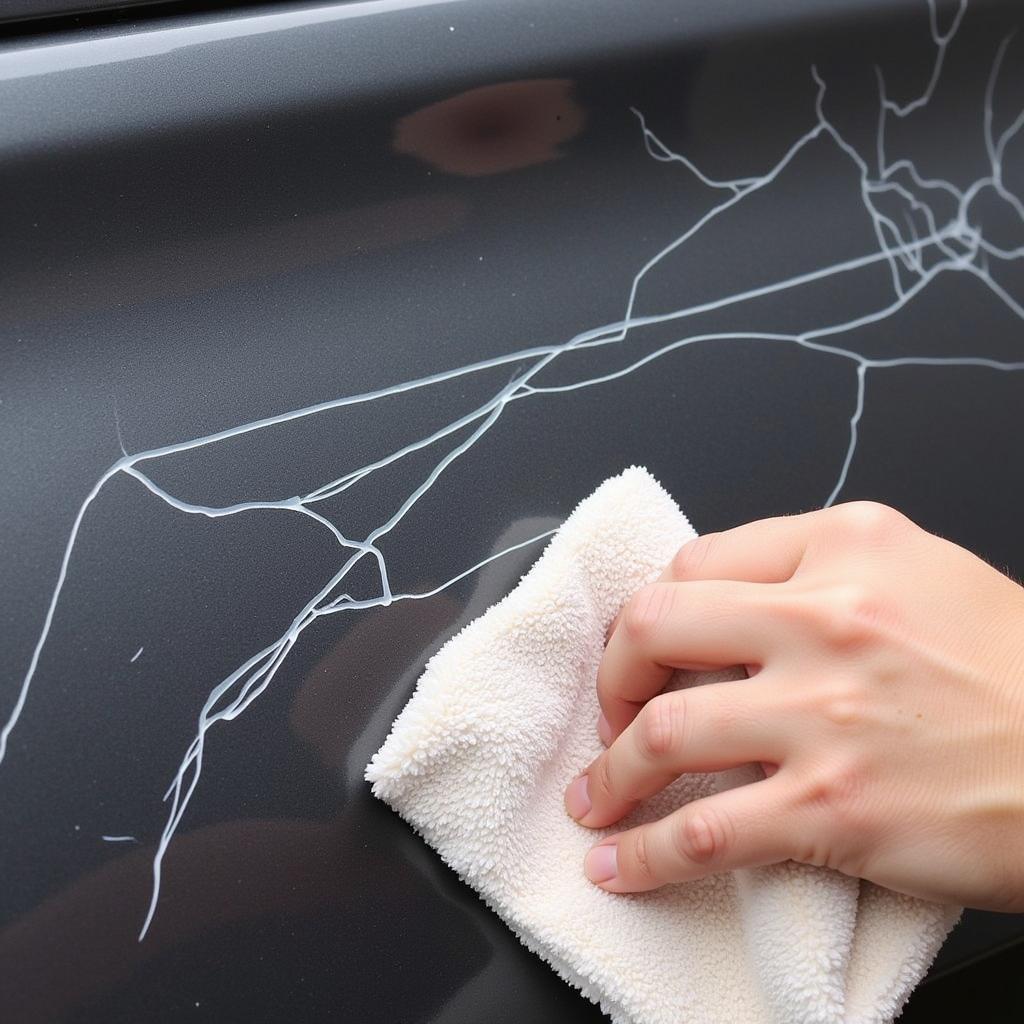Car paint crazing, that annoying web of fine cracks in your car’s finish, can be a real eyesore. This guide will teach you how to identify, understand, and fix car paint crazing, restoring your vehicle’s appearance to its former glory. We’ll cover everything from simple DIY solutions to more professional approaches, so you can choose the best method for your situation.
Understanding Car Paint Crazing
Car paint crazing resembles tiny, interconnected cracks in the paint surface, often appearing like a spiderweb or cracked porcelain. It’s primarily a cosmetic issue, rarely affecting the structural integrity of the car body. However, if left untreated, it can worsen over time, potentially leading to more severe paint damage like peeling or chipping.
Crazing occurs when the top layer of paint shrinks or contracts, while the underlying layers remain stable. This differential movement creates stress, causing the top layer to crack. Several factors can contribute to crazing, including:
- Improper paint application: Applying paint too thickly or in uneven coats can lead to uneven drying and stress, increasing the likelihood of crazing.
- Exposure to UV rays: Prolonged exposure to sunlight can degrade the paint’s elasticity, making it more susceptible to cracking.
- Harsh weather conditions: Extreme temperature fluctuations, especially freezing and thawing cycles, can cause the paint to expand and contract, contributing to crazing.
- Use of incompatible paint products: Applying a new layer of paint that’s chemically incompatible with the existing paint can create adhesion problems and induce crazing.
- Low-quality paint: Using cheap or low-quality paint can increase the risk of crazing, as these paints often lack the necessary durability and flexibility.
How to Fix Car Paint Crazing: DIY and Professional Solutions
Depending on the severity of the crazing, you can choose from several repair methods.
DIY Fixes for Minor Crazing
For minor crazing, you can often achieve satisfactory results with DIY solutions. These methods are generally less expensive and time-consuming than professional repairs.
-
Cleaning and Polishing: Thoroughly wash and dry the affected area. Then, use a high-quality polishing compound to gently buff the crazed paint. This can sometimes minimize the appearance of the cracks.
-
Rubbing Compound: A more abrasive rubbing compound can be used for slightly deeper crazing. Apply the compound with a soft cloth, rubbing in circular motions. Be careful not to rub too aggressively, as this can damage the surrounding paint.
 Applying Rubbing Compound to Crazed Car Paint
Applying Rubbing Compound to Crazed Car Paint
Professional Repair for Severe Crazing
If the crazing is severe or the DIY methods prove ineffective, professional repair is necessary. This usually involves repainting the affected area.
-
Sanding: The professional will sand down the crazed paint layer to create a smooth surface for the new paint.
-
Priming: A primer is applied to ensure proper adhesion of the new paint.
-
Repainting: The area is repainted with a high-quality automotive paint that’s compatible with the existing finish.
-
Clear Coat: A clear coat is applied to protect the new paint and enhance its gloss.
Preventing Car Paint Crazing
Prevention is always better than cure. Here are some tips to minimize the risk of car paint crazing:
-
Use high-quality automotive paint: Invest in reputable paint brands known for their durability and UV resistance.
-
Apply paint correctly: Follow the manufacturer’s instructions carefully, ensuring even coats and proper drying times.
-
Protect your car from the elements: Park your car in a garage or use a car cover to minimize exposure to sunlight and harsh weather.
-
Wash and wax regularly: Regular washing and waxing can help protect the paint and maintain its elasticity.
Conclusion
Car paint crazing can be a frustrating problem, but understanding its causes and knowing how to address it can save you time and money. Whether you opt for a DIY fix or professional repair, taking action can restore your car’s appearance and prevent further damage. For expert advice and assistance with any car repair needs, contact AutoTipPro at +1 (641) 206-8880 or visit our office at 500 N St Mary’s St, San Antonio, TX 78205, United States. We are always ready to help you get back on the road with a car you can be proud of.
FAQ
-
What does car paint crazing look like? It appears as a network of fine cracks in the paint, resembling a spiderweb or cracked porcelain.
-
Is car paint crazing serious? It’s primarily a cosmetic issue, but it can worsen if left untreated.
-
Can I fix car paint crazing myself? Minor crazing can often be addressed with DIY solutions like polishing or rubbing compound.
-
When should I seek professional help for car paint crazing? If the crazing is severe or DIY methods are ineffective, professional repainting is recommended.
-
How can I prevent car paint crazing? Use high-quality paint, apply it correctly, protect your car from the elements, and wash and wax regularly.
-
What causes car paint crazing? Several factors, including improper paint application, UV exposure, harsh weather, incompatible paint products, and low-quality paint.
-
How much does it cost to fix car paint crazing professionally? The cost varies depending on the severity of the damage and the size of the area that needs to be repainted. Consult with a professional for an accurate estimate.




Leave a Reply